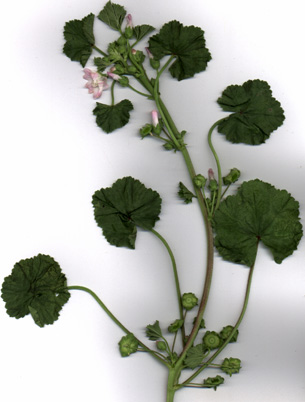
|
| Mallow; Malva neglecta L. |
Mallow Family; MALVACEÆ
|
| Wavy round leaves mark this mallow. It is related to a common ornamental, the towering hollyhock flower, which also bears
round leaves, only far larger (saucer-sized), thick and fuzzy. The
marsh mallow plant has pointed leaves, densely wooly, and was so
named because it grew in swampy or marshy sites. Other mallows exist, but the prize species for local weediness is the
small-flowered mallow, which is common in Tilth's garden and has resided in the Weed Patch happily for years. Come to the Tilth garden and
you can see it, as well as Hollyhock and Marsh Mallow. |
| You may eat mallow, either its leaves or young round seed-clusters, which are delightfully shaped like little buttons or
mini cheeses, complete with a wrapper. The plant is low in flavor but high in slipperiness. Chew some and you'll have a mouthful of
green slime, of scarce more flavor than grass. However, this mild, mucilaginous quality is an excellent foil for certain other plants
abrasive in taste or texture. Moreover, mallow is a superb source of iron, calcium and protein. Therefore, eat mallow with other salad greens.
It can be cooked, although I've not tried. Mostly I eat the immature seeds. Euell Gibbons, famous wild food writer, remarked
that mallow cheeses were "probably the first wild food" he ever ate. |
| The plant is an annual or short-lived perennial, with thick, plunging, branching roots. From the root spread various
rather recumbent stems, each with numerous long-stalked roundish leaves, interspersed with inconspicuous pale pink flowers. It
grows primarily in disturbed or cultivated soil. Easily uprooted, and not reseeding like a demon, mallow is no serious pest. As for size,
it usually attains by autumn about a foot in height, but covers a circle 3 to 5 feet wide. In rich, moist soil it will be larger; in crusty,
dry soil, smaller. A disgusting orange fungus called hollyhock rust
(Puccinia malvacearum, from Chile) usually infests it. |
There is a very similar, very rare mallow species that bears smaller flowers
(Malva parviflora); and a common third species that grows
with great upright vigor, bearing much larger, showy flowers
(Malva sylvestris). Both are equally edible, non-native weeds of
minor troubleness.
|
Originally published as the Seattle Tilth newsletter Weed of the Month in October 1992, along with an illustration from a book.
Back |
|
|

